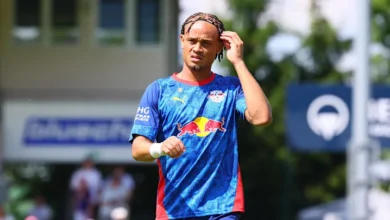
Chelsea have secured yet another exciting Brazilian talent, with Palmeiras’ teenage sensation Willian Estevão—nicknamed “Messinho”—set to join the club in the summer of 2025.
The 17-year-old winger has been on the radar of Europe’s elite clubs for years, and Chelsea’s €60 million investment underlines just how highly he is rated.
Estevão burst onto the scene as a 15-year-old with a hattrick in the Campeonato Brasileiro U17 final, helping Palmeiras to a 3-0 victory.
He followed that up with a standout performance in the U17 World Cup, contributing three goals and three assists, further cementing his status as one of Brazil’s brightest young prospects.
But is he worth the hefty price tag? And how does he fit into Chelsea’s tactical setup? Let’s break down his strengths, weaknesses, and potential impact at Stamford Bridge.
Willian Estevão: Tactical and Technical report
Tactical Fit and Playing Style
Versatile but Raw
Debuting for Palmeiras’ senior team at just 16, Estevão has already shown remarkable versatility. Primarily operating as a right-winger (RW) in a 4-2-3-1, he has also been deployed as a wing-back (WB), attacking midfielder (CAM), and even a center-forward (CF) in different systems. His ability to adapt to multiple roles is one of the traits that makes him such an intriguing prospect.
In Palmeiras’ system, he operates with a high and wide starting position, often hugging the touchline to create space for teammates like Endrick (CF) and Veiga (CAM), who are both left-footed and drift toward the right half-space. With an overlapping fullback behind him, Estevão plays a crucial role in stretching defenses and creating overloads on the right flank.
A Nightmare in 1v1 Situations
One of Estevão’s biggest strengths is his dribbling ability. Blessed with quick feet, exceptional agility, and a two-footed skillset, he is capable of beating defenders in tight spaces. His change of pace and trickery make him an absolute nightmare for opposition fullbacks.
Even when defenders manage to stop him, he remains fearless—constantly attempting take-ons until he finds a breakthrough.

He also excels at drawing fouls and penalties due to his low center of gravity and ability to shift direction rapidly. His resilience under pressure makes him a consistent threat in isolated 1v1 duels.
Developing Playmaking & Finishing
While Estevão has shown glimpses of being a wide playmaker, he still lacks consistency in his final ball. His vision is evident, as he frequently looks to play dangerous inswinging crosses and short, intricate passes in the final third. However, his execution needs refinement—he has yet to register an assist or create a big chance in over 400 minutes of senior football.
His shooting ability is one of the most exciting aspects of his game. With the ability to strike the ball with either foot, Estevão has an array of finishing techniques, but his decision-making under pressure is still a work in progress. His xG (expected goals) shot map suggests that he often takes low-percentage shots from outside the box rather than working into higher-quality scoring positions.
Off-Ball Intelligence & Movement
What sets Estevão apart from other raw wingers is his understanding of space and movement. Despite his young age, he consistently makes intelligent runs to exploit gaps in the opposition defense.
- Inside Runs: He frequently drifts inside to free up space for overlapping fullbacks and position himself in dangerous half-spaces.
- Off-the-Shoulder Runs: Uses his acceleration to break away from defenders, especially when attacking the far post.
- One-Twos: Shows an understanding of combination play, often using quick layoffs before making a diagonal run behind his marker.
However, he does struggle with offside awareness, sometimes ball-watching instead of adjusting his position to stay in play. Improving his timing and awareness will be crucial at the top level.
Physical & Defensive Aspects
At 5’7” and 62 kg, Estevão is lightweight and still developing physically. While his low center of gravity aids his dribbling, he can be muscled off the ball by stronger defenders. Fortunately, as seen with players like Vinícius Jr., young wingers can add muscle over time.
Defensively, he has a strong work ethic and presses aggressively, often chasing opponents over long distances. However, his defensive tracking is inconsistent, and he sometimes loses his marker in transitions. Given the defensive demands of the Premier League, he will need to refine his awareness and tactical discipline.
Why Chelsea Paid €60M
Chelsea’s pursuit of elite young talent has seen them target players like Andrey Santos, Deivid Washington, and Kendry Páez, and Estevão fits this recruitment model. The club is betting on his raw ability and potential rather than immediate output.
A player parallel to Estevão is Ángel Di María, another left-footed right winger known for his dribbling, creativity, and relentless movement. If developed correctly, Estevão could evolve into a player of similar influence. His playstyle also draws comparisons to Ousmane Dembélé at Borussia Dortmund, where Thomas Tuchel used him in a free-roaming creative role.
Chelsea’s possession-heavy system under Mauricio Pochettino (or any future manager) could benefit from Estevão’s ability to create space, beat defenders, and stretch the field. If he polishes his final ball and decision-making, he could become a major offensive weapon for the Blues.
Conclusion
Willian Estevão is an exciting yet unfinished talent. His dribbling, flair, and off-ball intelligence make him a high-ceiling prospect, but his physicality, decision-making, and defensive awareness need improvement before he can thrive in the Premier League.
At €60 million, Chelsea are making a bold investment in his potential. If he can refine his weaknesses and adapt to European football, Estevão could be another Brazilian superstar lighting up Stamford Bridge in the coming years. Whether he justifies the price tag will depend on how well he develops, but one thing is clear—Chelsea have secured a special talent for the future.





